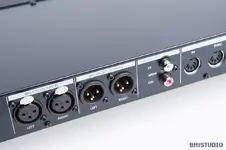Starstreams
Member
Just curious why more external FX units and even interfaces don't take advantage of more s/pdif I/O on the back? I don't know if optical ADAT is considered the new alternative, but I've heard from a few people that it can suffer from jitter. I won't speculate on that because I don't know. But as far as s/pdif goes, it seems to work great for me. It not only transfer midi data, but my reverbs, delay and chorus's comes into the computer all digital with no conversion. And s/pdif does not seem to suffer from noise as it's just 1s and 0s going down the line.
It just seems like a no brainier to me, that s/pdif would be cheap to implement. If you're lucky most interfaces will give you one, some don't give you any. I know on my T.C M1 FX unit, you can assign 2 independent stereo channels with the correct FX routing with one s/pdif in-out. The Right and Left each go to their own engine in the M1 and then are summed into stereo as two separate FXs. If there were 2 or 4 s/pdif connectors on modern interfaces, you could have more external FX units coming in all digital.
I know software plugins are the popular thing today, but there is still a huge advantage to using external units with regard to taking a load off the CPU. Especially with dense reverbs.
It just seems like a no brainier to me, that s/pdif would be cheap to implement. If you're lucky most interfaces will give you one, some don't give you any. I know on my T.C M1 FX unit, you can assign 2 independent stereo channels with the correct FX routing with one s/pdif in-out. The Right and Left each go to their own engine in the M1 and then are summed into stereo as two separate FXs. If there were 2 or 4 s/pdif connectors on modern interfaces, you could have more external FX units coming in all digital.
I know software plugins are the popular thing today, but there is still a huge advantage to using external units with regard to taking a load off the CPU. Especially with dense reverbs.

